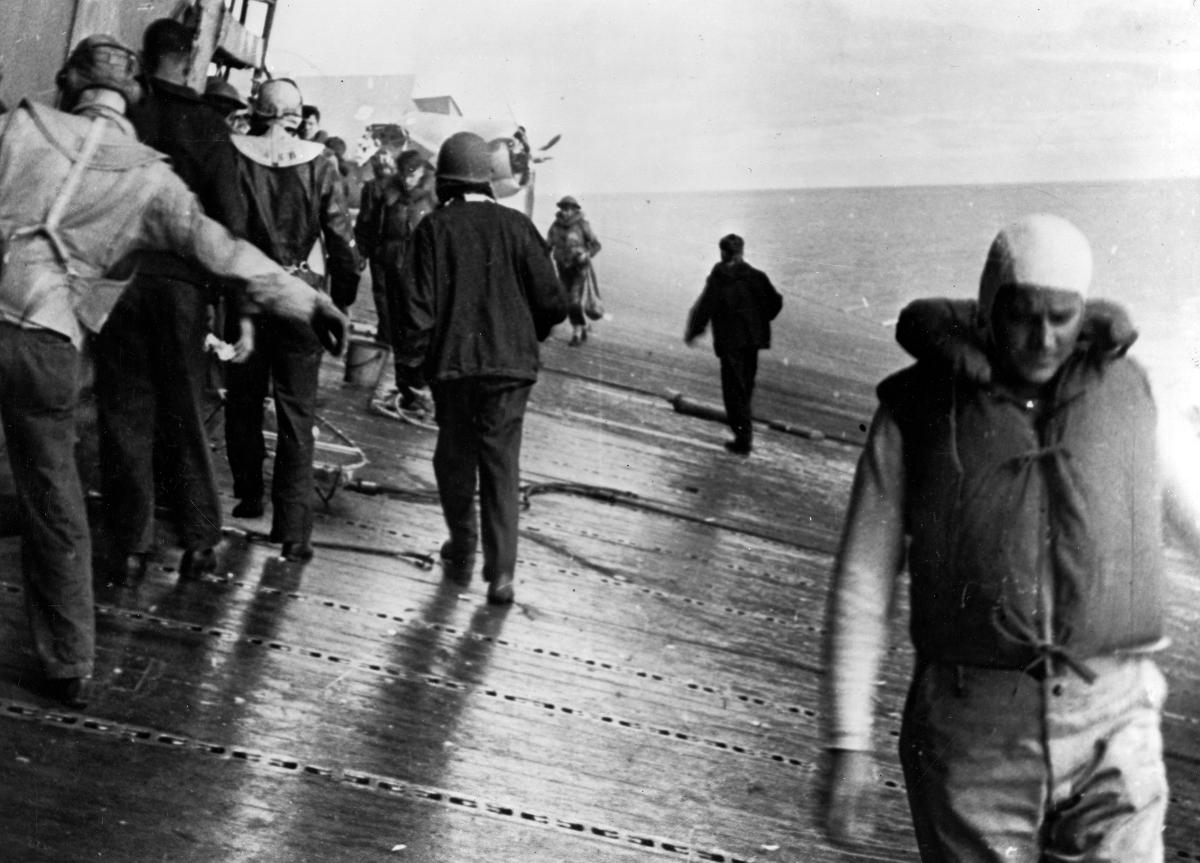During the Battle of Midway, then–Lieutenant Commander Joseph M. Worthington commanded the USS Benham (DD-397), rescuing hundreds of survivors off the USS Yorktown (CV-5) and Hammann (DD-412). (See “Fighting for Survival, December 2019, pp. 14–21.) In these reminiscences collected in his U.S. Naval Institute Oral History, he offers a vivid firsthand account of the action during that June 1942 clash that turned the tide of the Pacific war.
Shortly after noon on 4 June 1942, orders were received from our task force commander, Admiral Raymond A. Spruance, to join three other ships and proceed at maximum speed to reinforce the cruiser-destroyer screen of the aircraft carrier Yorktown, which was under heavy attack by Japanese carrier aircraft. Our small group had no sooner started in the direction of the Yorktown task force than we sighted dead ahead a huge column of smoke over the horizon, which was pouring skyward from the Yorktown’s first battle damage of the day.
Our ships took their stations in the screen, and as soon as possible all ships increased speed to the maximum the damaged carrier could attain. About 1432 the planes were reported approaching the formation, and about three minutes later the Benham opened fire on the enemy planes at maximum range bearing 270 degrees. The torpedo planes flew so low that they appeared to be dipping between the masts of the ships in the screen. Every antiaircraft gun in the task force which could be brought to bear was firing on the attacking planes. Some cruiser 8-inch guns also were firing on the attacking planes in the hope that the shell splashes would interfere with the accuracy of the torpedo fire.
During this attack Ensign Walter E. Pierce of the Benham was mortally wounded and four others also were wounded by fragments of an antiaircraft shell that struck the stack and severely damaged our only lifeboat. All the enemy planes were shot down, most of them by antiaircraft fire from our ships. I remember radically maneuvering the Benham to avoid being struck by falling flaming planes that hit the water close aboard. Some flaming aircraft narrowly missed other vessels in the screen as they crashed into the sea. The Benham was credited with assisting in shooting down five planes. Nevertheless, two torpedoes struck the Yorktown, and she quickly took a list toward the damaged side.
About 1500, the officers and men of the Yorktown climbed down cargo nets and ropes and slid into the sea, while several destroyers closed in to effect the rescue of some 2,300 men in the water. Life rafts were dropped into the ocean by all the ships in the vicinity. The one damaged lifeboat of the Benham was launched immediately and did splendid service both in rescuing personnel from the sea and in towing heavily loaded life rafts to the destroyer.
One near-tragedy occurred when another air attack was reported. The destroyers were ordered to cease rescue operations and resume their antiaircraft stations in the screen of the now-crippled carrier, which still lay dead in the water. The Benham interrupted rescue operations momentarily. But her position near the stern of the carrier, in the middle of hundreds of men close aboard waiting rescue, made it impossible to turn over the propellers without the great danger of injuring some of those struggling in the ocean to keep afloat.
Fortunately, this air attack was unable to penetrate the surface screen, and rescue operations were quickly resumed. When the first rescuing destroyers were loaded, they returned promptly to stations in the screen as ordered, and other destroyers relieved them in the lifesaving operations. Because of the Benham’s position in the middle of the floating mass of humanity in the sea she did not follow the prescribed procedure, but continued rescue operations. We took aboard, in all, 725 survivors of the aircraft carrier, by cargo nets, lifelines, rafts, stretchers, and our damaged lifeboat.
The task of caring for such a large number of survivors in so small a ship, with such limited facilities, was a stupendous one. All those taken aboard who were able to walk were directed aft to the fantail, where oil-soaked clothing was removed and thrown in a pile. Several hoses were led out to enable survivors to wash off as much oil as possible. The task of feeding so many from so small a galley also was quite an operation. Foods were quickly broken out from the storerooms, and the galley was operating to capacity on an around-the-clock basis.
Shortly after sunrise the following morning, Ensign Pierce was buried at sea—and the rescued chaplain from the Yorktown conducted the service.







